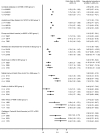Sociodemographic correlates of the increasing trend in prevalence of gestational diabetes mellitus in a large population of women between 1995 and 2005
- PMID: 18809630
- PMCID: PMC2584183
- DOI: 10.2337/dc08-1038
Sociodemographic correlates of the increasing trend in prevalence of gestational diabetes mellitus in a large population of women between 1995 and 2005
Abstract
Objective: Gestational diabetes mellitus (GDM) is an increasingly prevalent risk factor for the development of type 2 diabetes in the mother and is responsible for morbidity in the child. To better identify women at risk of developing GDM we examined sociodemographic correlates and changes in the prevalence of GDM among all births between 1995 and 2005 in Australia's largest state.
Research design and methods: A computerized database of all births (n = 956,738) between 1995 and 2005 in New South Wales, Australia, was used in a multivariate logistic regression that examined the association between sociodemographic characteristics and the occurrence of GDM.
Results: Between 1995 and 2005, the prevalence of GDM increased by 45%, from 3.0 to 4.4%. Women born in South Asia had the highest adjusted odds ratio (OR) of any region (4.33 [95% CI 4.12-4.55]) relative to women born in Australia. Women living in the three lowest socioeconomic quartiles had higher adjusted ORs for GDM relative to women in the highest quartile (1.54 [1.50-1.59], 1.74 [1.69-1.8], and 1.65 [1.60-1.70] for decreasing socioeconomic status quartiles). Increasing age was strongly associated with GDM, with women aged >40 years having an adjusted OR of 6.13 (95% CI 5.79-6.49) relative to women in their early 20s. Parity was associated with a small reduced risk. There was no association between smoking and GDM.
Conclusions: Maternal age, socioeconomic position, and ethnicity are important correlates of GDM. Future culturally specific interventions should target prevention of GDM in these high-risk groups.
Figures


References
-
- International Diabetes Federation: Diabetes Atlas 2006. 3rd ed. Brussels, International Diabetes Federation, 2006
-
- Cheung NW, Byth K: Population health significance of gestational diabetes. Diabetes Care 26:2005–2009, 2003 - PubMed
-
- Ben-Haroush A, Yogev Y, Hod M: Epidemiology of gestational diabetes mellitus and its association with type 2 diabetes. Diabet Med 21:103–113, 2004 - PubMed

